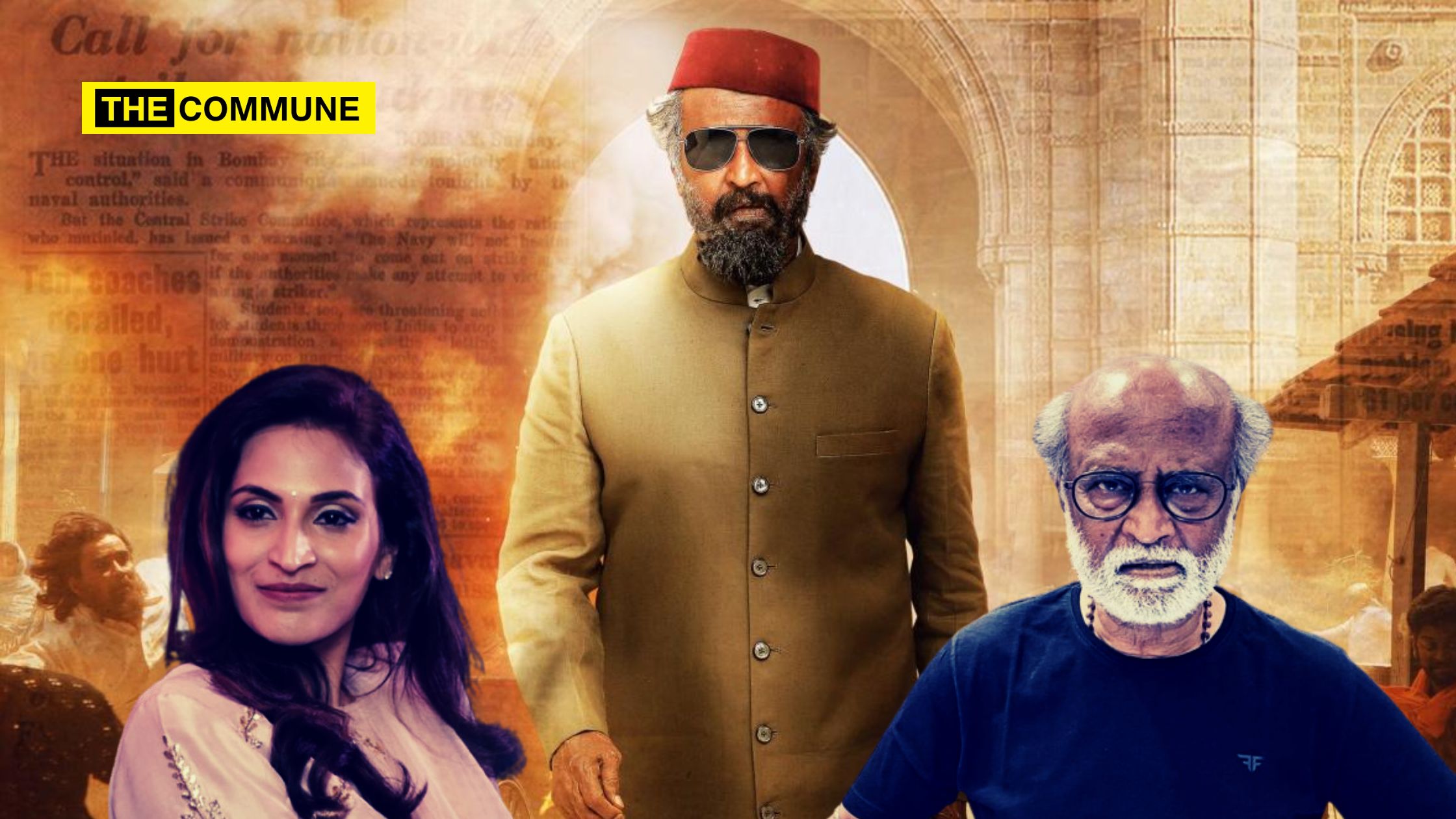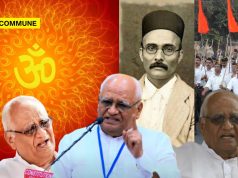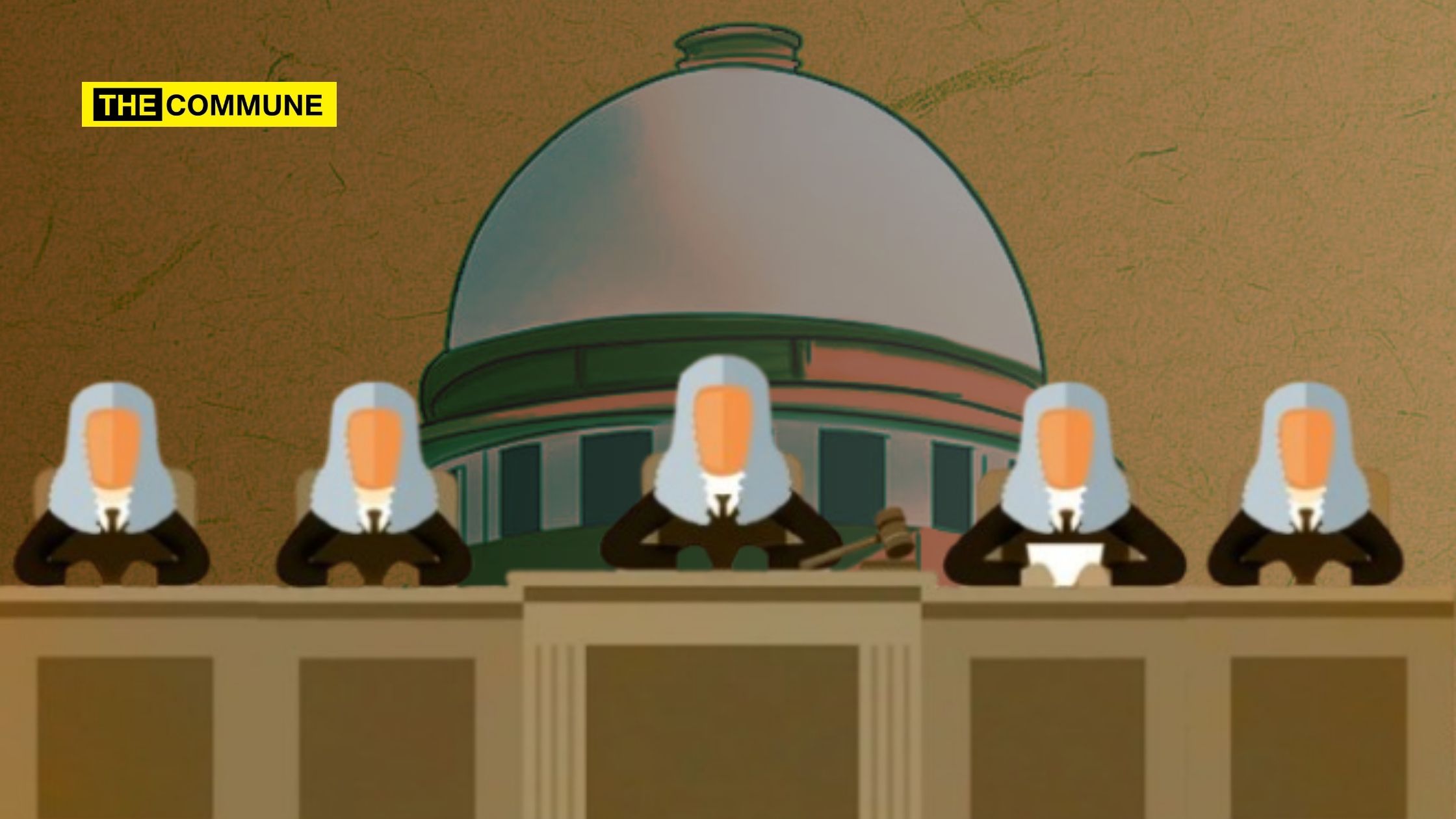
Why was the film named Lal Salaam? During the film’s audio launch speech, Rajini explains – “Red has many faces. Red is associated with communism. Red is also associated with danger. Red is used to symbolise violence. Red also represents revolution. Aishwarya utilises red as a symbol of revolution in her story. ‘Salaam’ means greetings. So ‘Lal Salaam’ is a greeting to revolution because the story itself is like that. A revolutionary tale!”
Towards the end of this review, you will find out which red the Lal in Lal Salaam denotes.
The film begins with Aishwarya herself doing the narration. Her deep voice pops in here and there to explain the situation to the audience.
The premise is that to secure votes, politicians divide a harmonious relationship in a fictitious village called Muradbad – wonder if there is some such village in Tamil Nadu. But after watching the film, one can only shout – “Lal Salaam Murdabad!”
By the first 30-odd minutes, we understand that the film is about cricket, Mariamman ther (chariot) festival, politics, riots, and communalism. What a heady mix! The story goes back and forth between the past and present, making it all the more confusing and tiring for the viewer.
Thirunavukkarasu, or Thiru, played by Vishnu Vishal, is sent to jail and is released on bail after six months; when he comes out, he is shown to wear the Taveez – you wonder why it is displayed; you will find the answer towards the end of the film. He comes back from jail but is shunned by everyone in the village. But our hero meets his love interest and sings songs right after this. You expect something to develop on that front, but no. There’s something else.
Cricket comes into the picture now – it is perhaps the most unconvincing aspect connected to a small village in Tamil Nadu. Well, it is fiction, so let’s see where this goes.
Rajinikanth makes his entry at about 25 minutes into the film in what one would see as one of the most underwhelming entries of all time. He makes his entry in the backdrop of the constipated screams of Jalali Jalali by AR Rahman.
Moideen, the character that Rajinikanth plays, is shown to be the epitome of all virtues, and guess what? He speaks about halal (lawful) and haraam (forbidden) but also beats up people. Beating up people is halal or haraam?
There are too many characters in the film, and it is unclear if Aishwarya wanted to do justice to each of them, as half of the characters appear for a maximum of 5 minutes. Here is a list of those characters:
KS Ravikumar, who plays a politician, is shown for a few minutes in the beginning. He appears for a few seconds in the middle of the film – for what, god knows.
Thiru’s love interest also appears for a maximum of 5 minutes and then for one scene in the second half. She is nowhere to be seen for the rest of the film.
Nirosha, who plays Moideen/Rajini’s wife, also has very few dialogues to mouth; she stands there in scenes like a prop.
Two villain characters in the Bombay scenes also appear for a few minutes each.
At the film’s beginning, it is shown that the year is 1993. Guess what? Kapil Dev also enters into this already big confusion. He is shown as a cricket coach, but it was in 1994 that Kapil retired. So, what are they trying to establish here? God knows…
There are some very cliched dialogues about Moideen’s love for his wife – he compares it with that of Shahjahan and Mumtaz. Or the one where Moideen preaches that Muslims who stayed back in India during partition did so out of love/patriotism for the country – ho-hum. These tropes have been debunked long back; please give us something new.
This film has more enjoyable cricket than Blue Star, which was touted as a sports film. Thiru and Shamsuddin (Moideen’s son), played by Vikrant, play some great cricket.
Politicians are shown to manipulate communal sentiments, toying with the people’s emotions. But they had to show them as Hindus. In today’s time and age, it is clear as crystal who makes inflammatory statements, calls for Sar Tan Se Juda, and who talks about the treatment of Kaffirs.
Usual Secularist Tropes
The portrayal of the villain as a Hindu and the do-gooder as a Muslim in the narrative follows a seemingly calculated script of perfect secularism. The storyline accentuates a divisive depiction by illustrating Hindus as lacking unity while presenting Muslims as remarkably united. This deliberate narrative choice not only perpetuates stereotypes but also raises questions about the underlying motives and biases within the storytelling.
The two heroes are depicted in contrasting ways: Thiru, the Hindu protagonist, is portrayed as a drunkard who disregards his mother’s advice, engages in physical altercations, and embraces violence. On the other hand, Shamsu, the Muslim hero, is presented as highly focused, attentive to his parents’ guidance, and devoid of any detrimental habits.
The contrast between the Islamic festival, where all Hindus participate, and the Hindu theru festival reveals a notable disparity. The Hindu villains are shown as taking the guise of Muslims wearing skullcaps and are shown as instigators of riots. The narrative takes a distressing turn when the Hindu antagonist inflicts permanent harm on Moideen’s son. Was this the current “climate” Aishwarya mentioned in her speech? Real Hindus never indulge in such cowardly acts of pretending to be Muslims to start a riot. Such portrayals only perpetuate harmful stereotypes.
Towards the end, the revelation about how the taveez saves Thiru feels like a predictable and overused trope.
Some Other Observations
The Hindu festivals are portrayed with the right zeal, accompanied by a song that evokes the right celebratory emotions for just a few minutes.
While discussing logic in cinema is probably incorrect, this one could not be overlooked. Shamsu, after losing his arm, tries to hang himself with one hand. The entire film is like this – zero cohesiveness and clarity.
The person who played the character, Michael, speaks inspirational stuff much better than Rajini himself. Senthil and Thambi Ramaiah act with conviction. Thiru and Shamsu do their best to play their parts. The face of the film, Rajinikanth, fails at emoting in what could have been a heart-wrenching scene – when he hears about Shamsu losing his arm, Moideen/Rajini emotes poorly, while Nirosha does better.
In fact, Thambi Ramaiah and the character depicting Mariamma show more profound emotion when the theru is burnt than Rajini when he learns his son has lost a hand. For a seasoned actor, he fails to bring out the emotions of a parent.
This film could have been made into something entirely different, perhaps focusing solely on sports, but the communal element just had to be there to peddle the propaganda of political masters. With a runtime of 2.5 hours, the film feels excessively long, lacking any substantial content.
Towards the end, Rajini performs some stunts, which will probably thrill the Rajini fans and frontbenchers, but that is all there is to this film.
In the concluding scene, the theru (chariot) magically reappears (after it gets burnt, thanks to the villain in the previous scene), courtesy of Moideen, who actively participates in the festival and carries the idol to the theru. Now, is this haraam or halal? #JustAsking
As a viewer, as the film ends, one would indeed feel like Vivek as Emotional Ekambaram from the film Utamaputhiram – “Confusion of the constitution of the institution of the loose motion!”
Father & Daughter
This is Aishwarya’s 3rd directorial venture, and she still hasn’t gotten a grip on things. She fails miserably on all fronts. There are too many people in the mix – big names, small names, unnecessary characters – everything feels forced fit to go by the secularism playbook where Hindus are the villains. This film is much worse than her UN “dance” performance.
Rajini seems to have taken up this film to save his daughter from misery – as per her speech at the Lal Salaam audio launch, where she confessed that no one came forward to be a part of this film or act in the Moideen role. To avoid looking like a failure, she spun it as “If Rajinikanth were a Sanghi, he wouldn’t have acted in the film Lal Salaam. A Sanghi cannot act in this film. Only a humanist can act in such a film. Only Rajini has that courage; no one else could have done it.”
Only a fool would have taken up this project to show their “humanity” towards her – no one in their right mind would have taken up this completely rubbish script with poor screenplay and direction. And she said this role was worth a National Award? Who was she kidding? And a revolutionary tale? Yes, we are all laughing.
In her Lal Salaam audio launch speech, Aishwarya also mentioned, “My film will be on all your lists.” Yes, in the To-Avoid list. The meaning of Lal in Lal Salaam is, as mentioned by Rajinikanth – danger – take it as a warning to avoid the film at all costs; not even worth a watch on OTT, save yourselves the headache.
If you happen to watch the film and get one, try to get some comic relief by watching the below video.
Old video of #AishwaryaRajinikanth goes viral after her "My father is not a Sanghi" remark. #Rajinikanth𓃵 #LalSalaamAudioLaunch pic.twitter.com/t0xIiVBYmq
— The Commune (@TheCommuneMag) January 27, 2024
Subscribe to our channels on Telegram, WhatsApp, and Instagram and get the best stories of the day delivered to you personally.




